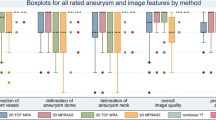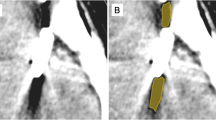Abstract
Objective
To assess the diagnostic accuracy of 256-row multislice computed tomographic angiography (CTA) compared with three-dimensional rotational angiography (3DRA) in the postoperative evaluation of cerebral aneurysms treated with titanium clips.
Methods
A total of 128 patients (42 men, 86 women; mean age, 57.6 years) with 143 cerebral aneurysms treated using titanium clips underwent both CTA and 3DRA. Two reviewers retrospectively evaluated the following parameters on CTA and 3DRA: (1) residual/recurrent aneurysm (absent or present), (2) patency of parent artery (patent or occluded/severe stenotic (> 70%)), and (3) patency of adjacent branch (patent or occluded/absent).
Results
A total of 24 residual/recurrent aneurysms were detected by 3DRA. The sensitivity, specificity, and accuracy of CTA for the detection of residual/recurrent aneurysms were 83.3%, 100%, and 97.2% for reviewer 1 and 79.2%, 100%, and 96.5% for reviewer 2, respectively. The sensitivity, specificity, and accuracy of CTA for the evaluation of patency of parent artery were 100%, 100%, and 100%, respectively, for both reviewers. The sensitivity, specificity, and accuracy of CTA for evaluation of the patency of adjacent branch were 85.1%, 100%, and 92.3% for reviewer 1 and 82.4%, 100%, and 90.9% for reviewer 2, respectively.
Conclusion
A 256-row multislice CTA is a valuable non-invasive tool for assessment of cerebral aneurysms treated with titanium clips.
Key Points
• A 256-row multislice CTA is an accurate imaging technique for the postoperative assessment of cerebral aneurysms treated with titanium clips.
• Sensitivity of CTA for the detection of residual/recurrent aneurysms was 79–83% compared with 3DRA.
• CTA is still limited in detecting residual/recurrent aneurysms of < 2 mm and small adjacent branches.



Similar content being viewed by others
Abbreviations
- 3DRA:
-
Three-dimensional rotational angiography
- CTA:
-
Computed tomographic angiography
- DSA:
-
Digital subtraction angiography
- SAH:
-
Subarachnoid hemorrhage
- VR:
-
Volume rendering
References
Cloft HJ, Joseph GJ, Dion JE (1999) Risk of cerebral angiography in patients with subarachnoid haemorrhage, cerebral aneurysm, and arterio-venous malformation: a meta-analysis. Stroke 30:317–320
Van Loon JJ, Yousry TA, Fink U, Seelos KC, Reulen HJ, Steiger HJ (1997) Postoperative spiral computed tomography and magnetic resonance angiography after aneurysm clipping with titanium clips. Neurosurgery 41:851–857
Teksam M, McKinney A, Cakir B, Truwit CL (2004) Multi-slice computed tomography angiography in the detection of residual or recurrent cerebral aneurysms after surgical clipping. Acta Radiol 45:571–576
Lee JH, Kim SJ, Cha J et al (2005) Postoperative multidetector computed tomography angiography after aneurysm clipping: comparison with digital subtraction angiography. J Comput Assist Tomogr 29:20–25
Sagara Y, Kiyosue H, Hori Y, Sainoo M, Nagatomi H, Mori H (2005) Limitations of three-dimensional reconstructed computerized tomography angiography after clip placement for intracranial aneurysms. J Neurosurg 103:656–661
Dehdashti AR, Binaghi S, Uske A, Regli L (2006) Comparison of multislice computerized tomography angiography and digital subtraction angiography in the postoperative evaluation of patients with clipped aneurysms. J Neurosurg 104:395–403
Sakuma I, Tomura N, Kinouchi H et al (2006) Postoperative three-dimensional CT angiography after cerebral aneurysm clipping with titanium clips: detection with single detector CT. Comparison with intra-arterial digital subtraction angiography. Clin Radiol 61:505–512
Han MH, Kim YD (2007) Role of multislice computerized tomographic angiography after clip placement in aneurysm patients based on comparison with three dimensional digital subtraction angiography. J Korean Neurosurg Soc 42:103–111
Chen W, Yang Y, Qiu J, Peng Y, Xing W (2008) Sixteen-row multislice computerized tomography angiography in the postoperative evaluation of patients with intracranial aneurysms. Br J Neurosurg 22:63–70
Pechlivanis I, Koenen D, Engelhardt M et al (2008) Computed tomographic angiography in the evaluation of clip placement for intracranial aneurysm. Acta Neurochir (Wien) 150:669–676
Watanabe Y, Kashiwagi N, Yamada N et al (2008) Subtraction 3D CT angiography with the orbital synchronized helical scan technique for the evaluation of postoperative cerebral aneurysms treated with cobalt-alloy clips. AJNR Am J Neuroradiol 29:1071–1075
Uysal E, Ozel A, Erturk SM, Kirdar O, Basak M (2009) Comparison of multislice computed tomography angiography and digital subtraction angiography in the detection of residual or recurrent aneurysm after surgical clipping with titanium clips. Acta Neurochir (Wien) 151:131–135
Bharatha A, Yeung R, Durant D et al (2010) Comparison of computed tomography angiography with digital subtraction angiography in the assessment of clipped intracranial aneurysms. J Comput Assist Tomogr 34:440–445
Gerardin E, Tollard E, Derrey S et al (2010) Usefulness of multislice computerized tomographic angiography in the postoperative evaluation of patients with clipped aneurysms. Acta Neurochir (Wien) 152:793–802
Thines L, Dehdashti AR, Howard P et al (2010) Postoperative assessment of clipped aneurysms with 64-slice computerized tomography angiography. Neurosurgery 67:844–854
Tomura N, Sakuma I, Otani T et al (2011) Evaluation of postoperative status after clipping surgery in patients with cerebral aneurysm on 3-dimensional-CT angiography with elimination of clips. J Neuroimaging 21:10–15
Thaker NG, Turner JD, Cobb WS et al (2012) Computed tomographic angiography versus digital subtraction angiography for the postoperative detection of residual aneurysms: a single-institution series and meta-analysis. J Neurointerv Surg 4:219–225
Gölitz P, Struffert T, Ganslandt O, Lang S, Knossalla F, Doerfler A (2014) Contrast-enhanced angiographic computed tomography for detection of aneurysm remnants after clipping: a comparison with digital subtraction angiography in 112 clipped aneurysms. Neurosurgery 74:606–614
Dolati P, Eichberg D, Wong JH, Goyal M (2015) The utility of dual-energy computed tomographic angiography for the evaluation of brain aneurysms after surgical clipping: a prospective study. World Neurosurg 84:1362–1371
Sindou M, Acevedo JC, Turjman F (1998) Aneurysmal remnants after microsurgical clipping: classification and results from a prospective angiographic study (in a consecutive series of 305 operated intracranial aneurysms). Acta Neurochir (Wien) 140:1153–1159
David CA, Vishteh AG, Spetzler RF, Lemole M, Lawton MT, Partovi S (1999) Late angiographic follow-up review of surgically treated aneurysms. J Neurosurg 91:396–401
Feuerberg I, Lindquist C, Lindqvist M, Steiner L (1987) Natural history of postoperative aneurysm rests. J Neurosurg 66:30–34
Eldawoody H, Mazrou J, Hamad S, AbdelRahman A, Elmogy S (2018) The value of CT angio brain for follow up of clipped cerebral aneurysms; the impact of aneurysm clip material. Internet J Neurosurg 14
Zachenhofer I, Cejna M, Schuster A, Donat M, Roessler K (2010) Image quality and artefact generation post-cerebral aneurysm clipping using a 64-row multislice computer tomography angiography (MSCTA) technology: a retrospective study and review of the literature. Clin Neurol Neurosurg 112:386–391
Bier G, Bongers MN, Hempel JM et al (2017) Follow-up CT and CT angiography after intracranial aneurysm clipping and coiling-improved image quality by iterative metal artifact reduction. Neuroradiology 59:649–654
Mocanu I, Van Wettere M, Absil J, Bruneau M, Lubicz B, Sadeghi N (2018) Value of dual-energy CT angiography in patients with treated intracranial aneurysms. Neuroradiology 60:1287–1295
Uricchio M, Gupta S, Jakowenko N et al (2019) Computed tomography angiography versus digital subtraction angiography for postclipping aneurysm obliteration detection. Stroke 50:381–388
Chen W, Xing W, He Z, Peng Y, Wang C, Wang Q (2017) Accuracy of 320-detector row nonsubtracted and subtracted volume CT angiography in evaluating small cerebral aneurysms. J Neurosurg 127:725–731
Kang HS, Han MH, Kwon BJ et al (2004) Postoperative 3D angiography in intracranial aneurysms. AJNR Am J Neuroradiol 25:1463–1469
Funding
The authors state that this work has not received any funding.
Author information
Authors and Affiliations
Corresponding author
Ethics declarations
Guarantor
The scientific guarantor of this publication is Dae Young Yoon.
Conflict of interest
The authors of this manuscript declare no relationships with any companies whose products or services may be related to the subject matter of the article.
Statistics and biometry
No complex statistical methods were necessary for this paper.
Informed consent
Written informed consent was waived by the Institutional Review Board.
Ethical approval
Institutional Review Board approval was obtained.
Methodology
• Retrospective
• Observational
• Performed at one institution
Additional information
Publisher’s note
Springer Nature remains neutral with regard to jurisdictional claims in published maps and institutional affiliations.
Rights and permissions
About this article
Cite this article
Kim, H.J., Yoon, D.Y., Kim, E.S. et al. 256-row multislice CT angiography in the postoperative evaluation of cerebral aneurysms treated with titanium clips: using three-dimensional rotational angiography as the standard of reference. Eur Radiol 30, 2152–2160 (2020). https://doi.org/10.1007/s00330-019-06560-7
Received:
Revised:
Accepted:
Published:
Issue Date:
DOI: https://doi.org/10.1007/s00330-019-06560-7




